|
Until its demolition in August 2004 this small, red-bricked building (pictured above) stood opposite the former Robin Hood pub at the corner of Chantry Road for about 140 years. It was originally built as a shoeing Smithy, possibly by a local vet with a view to expand his business, but several owners later was bought in 1904 by Sir Walter Gilbey. The tenant at that time was Arthur Rayment.
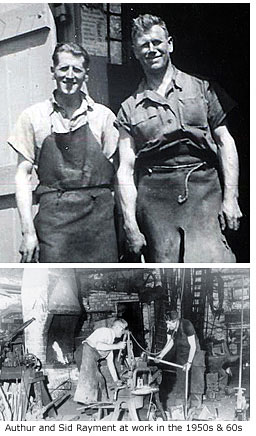 At Gilbey's death his estate was auctioned in 1917, allowing Rayment to buy the forge – hence the name – which he continued to run with his son (also Arthur) and later his grandsons Arthur and Sidney, who eventually took over the business. At Gilbey's death his estate was auctioned in 1917, allowing Rayment to buy the forge – hence the name – which he continued to run with his son (also Arthur) and later his grandsons Arthur and Sidney, who eventually took over the business.
But by 1964, with horse transport long since super-ceeded by the combustion engine, the Rayment brothers were forced to diversify and used their skills to make ornate metal work for churches and cathedrals. When retirement beckoned in the early 1970s they sold up. The forge that had been in constant use for over one hundred years was then removed and the property extended and refurbished for use as a private business.
From the early 1900s until the mid 1980s, the plot of land alongside Rayment's Forge (below left) was the Thursday venue for Watson's poultry, game and produce auction market. The local Women’s Institute (W.I.) also raised funds here by selling home produce, continuing to do so until 1999 when the land was acquired for property development. The W.I. then moved to the old stables of the Half Moon Inn at the corner of North Street where they have continued to sell their produce ever since. The site (including Rayment's Forge) was finally cleared in 2004 and replaced in 2005/06 by the apartment block that is named Watson's Yard.
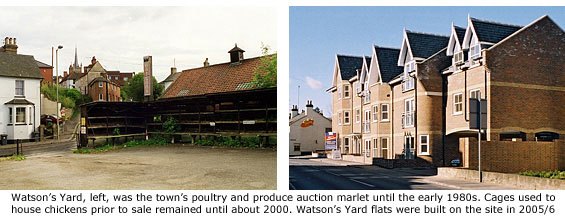
|
|
The renowned art and architectural historian Nikolaus Pevsner (1902–1983) wrote a number of books on the architecture of English counties that gained him great aclaim. When he visited Bishop’s Stortford in the early 1950s his overall impression of the town was favourable, but he dismissed the Chantry as a ‘glaring example of how a shop and a bit of showy half-timbering can ruin an important vista’.
Sadly, things haven't improved since he made that statement, this once elegant 16th century building now suffering from a severe case of over-commercialisation, tacky ornamental street furniture and an excess of pink paint. Thankfully, its past history is somewhat more interesting.
When a local man by the name of Baldwyn Victor died in the 15th century, his widow, Marjorie, set up an endowment in his memory – its aim being to fund a chantry priest who would celebrate Divine Service daily at the altar of St John the Baptist in St Michael’s church. At that time there was already two guilds in the church with their own altar, namely St Mary and St Michael.
To fulfill the endowment, two churchwardens from St Michael’s hired a small boat in the winter of 1482 and rowed it, via the river Stort, river Lea and river Thames, to Fulham in London where they negotiated with Bishop Kempe to acquire chantry lands in Bishop’s Stortford. Three years later a licence was finally granted and one of the areas of land acquired was here; termed then as ‘Shortcrofts in Moche Half Acres’
A Chantry house was built and a priest, Thomas Sympson, installed. But following Henry VIII's order for the Dissolution of the Chantries – continued after his death by his son Edward VI – the priest was ejected from his living in 1557 and the Chantry demolished. (Thomas Sympson was later installed as vicar of St Michael’s from 1560–1571). As with the Dissolution of the Monasteries some years before, it was normal practice to sell off the the land acquired by the Crown to rich merchants or nobles who would then often salvage much of the material from the demolished buildings and erect their own house on the same site. In this case the Chantry lands are thought to have been sold to two King’s Commissioners, one of whom possibly built the house that stands here today and which is now named the Chantry in memory of the original building.
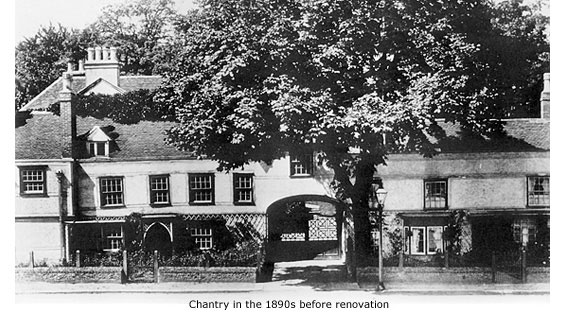
In 1583 the house was owned by one Oliver Godfrey and his wife, but that same year sold to Thomas Bower who, when he died in 1607, left it to his two-year-old daughter. How many owners the house had after that time isn’t known but the demise of these premises and its entry into the commercial world seems to have begun in the early 19th century.
Probably with the intention of making extra money, the owner at that time extended the building's eastern end to house two small shops – a Confectioners and a Bakers – but in 1865 converted them into a public house called the Eagle. That establishment survived until 1896 when the Chantry's new owner, Sir Walter Gilbey, demolished it and installed two bay windows in the building's end wall. Those same windows now overlook the small garden and car park where the pub once stood. Gilbey sold the Chantry in 1910.
The large tree that once stood near to the Chantry's main entrance, and features in all early photographs, eventually became unsafe and was taken down in the early 1900s. The building once again became a commercial outlet in 1932 when it was occupied by Grays – a part of Handscomb’s – selling garden equipment and machinery. They ceased trading in the mid 1980s, but further conversion and refurbishment took place to accommodate smaller shops and a modern extension at the building's western end.
Directly opposite the Chantry, two large advertising hoardings mark the former site of three cottages and a workshop, homes and workplace to three generations of the Mills family who, between 1830 and 1930, made leather footwear and harnesses. At this same spot in the early 1900s, ostlers would stand with horses, carts, ponies and tubs waiting to receive the goods their employers had bought in the market. MORE PICTURES
|
|
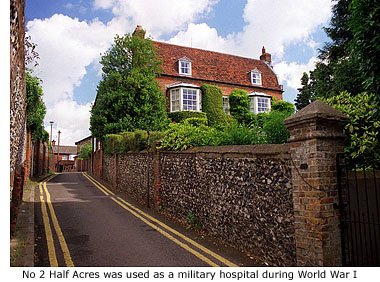 Before the Dissolution of the Chantries the land here produced a rental of £8 per annum for Bishop’s Stortford’s Chantry. After the Dissolution it was bought by two King’s Commissioners who sold it soon after, and it was later rented out for two years to one John Jacob at a cost to him of 5s (25p). Before the Dissolution of the Chantries the land here produced a rental of £8 per annum for Bishop’s Stortford’s Chantry. After the Dissolution it was bought by two King’s Commissioners who sold it soon after, and it was later rented out for two years to one John Jacob at a cost to him of 5s (25p).
The land then changed hands several times, but in the late 16th century was in the ownership of the Miller family who sealed off a cart track that went across Half Acres. Local people used it as a short-cut between Northgate End and Green Lane (later Love Lane and now Cricketfield Lane) and though the Millers succeeded at impeding the way for several years, the track was eventually re-opened. Now called Half Acres, it is still used as a short-cut to Elm Road but at its far end the track is now little more than a pathway between houses.
Behind the high flint and mortar wall originally built to enclose the Chantry garden stands a magnificent 19th century house named Chantry Villa. Privately owned, it was once home to prominent town resident, Alfred Slapps Barrett (See Guide 6).
The former site of the Banana warehouse is now a small housing development called Shortlands, and directly opposite stands No 2 Half Acres, a beautifully styled 18th century house built of red brick that is perfectly positioned on this hill to enjoy marvellous views across the town. For a brief period during the First World War it was used as a hospital for wounded soldiers to recuperate, brought to Bishop’s Stortford by train and then ferried here from the station by ambulance.
|


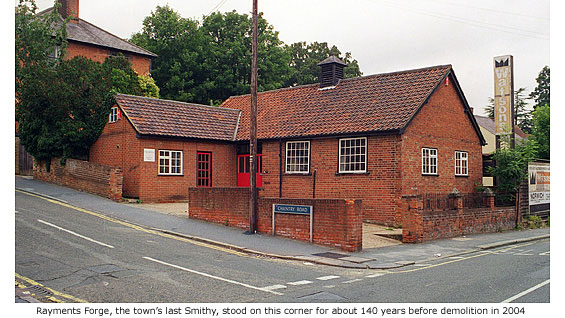
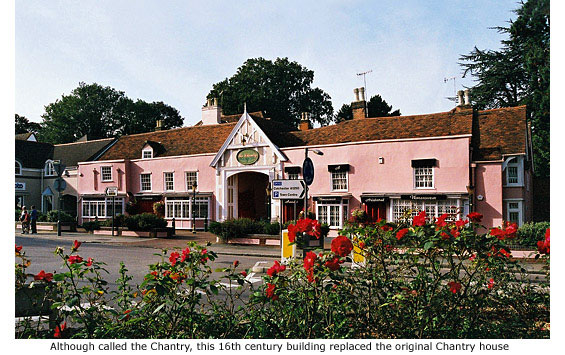

 At Gilbey's death his estate was auctioned in 1917, allowing Rayment to buy the forge – hence the name – which he continued to run with his son (also Arthur) and later his grandsons Arthur and Sidney, who eventually took over the business.
At Gilbey's death his estate was auctioned in 1917, allowing Rayment to buy the forge – hence the name – which he continued to run with his son (also Arthur) and later his grandsons Arthur and Sidney, who eventually took over the business.

 Before the Dissolution of the Chantries the land here produced a rental of £8 per annum for Bishop’s Stortford’s Chantry. After the Dissolution it was bought by two King’s Commissioners who sold it soon after, and it was later rented out for two years to one John Jacob at a cost to him of 5s (25p).
Before the Dissolution of the Chantries the land here produced a rental of £8 per annum for Bishop’s Stortford’s Chantry. After the Dissolution it was bought by two King’s Commissioners who sold it soon after, and it was later rented out for two years to one John Jacob at a cost to him of 5s (25p).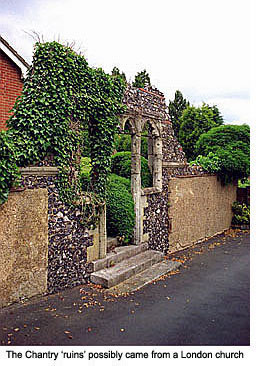
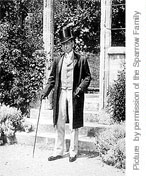 At the rear of the Chantry stands part of a flint-stone church wall with two arched windows. It is generally referred to as the ‘Chantry ruins’, but the more common belief is that the masonry came either from St Michael’s Church during 19th century renovation work, or was part of an old church that once stood in Blackfriars, London.
At the rear of the Chantry stands part of a flint-stone church wall with two arched windows. It is generally referred to as the ‘Chantry ruins’, but the more common belief is that the masonry came either from St Michael’s Church during 19th century renovation work, or was part of an old church that once stood in Blackfriars, London.